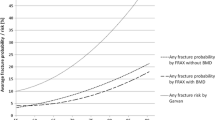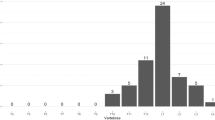Abstract
Background and aims: The incidence of fractures is high in older populations. More information is needed about long-term predictors of fractures, for preventive measures. The aim of this study was to analyze gender-specific predictors of fractures among persons aged 65 years or older during a 12-year follow-up. Methods: A true cohort study in the municipality of Lieto, southwestern Finland, started in October 1990. Baseline data and information about fractures in 1177 subjects (482 men, 695 women), mean age 73 years (range 65–97), were obtained individually from health care registers during 1991–2002. The mean follow-up period was 8.5 years. Subjects having sustained at least one fracture (n=295) were compared with subjects with no fractures during the follow-up. Predictors of fractures were analyzed using a Poisson regression model, separately by gender. Results: In multivariate Poisson regression analyses, the following predictors of fractures during the 12-year follow-up were identified: reduced handgrip strength (RR 1.6, 95% CI 1.1–2.3 in middle quartiles, RR 2.2, 95% CI 1.4–3.5 in lowest quartile) and body mass index (BMI) 25–29.9 (RR 1.9, 95% CI 1.3–2.7) or BMI <25 (RR 2.0, 95% CI 1.4–2.9) compared with BMI 30 or over among women, and a large number of depressive symptoms (RR 2.1, 95% CI 1.2–3.6) among men. A compression fracture in one or more thoracic or upper lumbar vertebrae on chest radiography at baseline was associated with fractures in both women (RR 2.0, 95% CI 1.3–3.0) and men (RR 3.5, 95% CI 1.9–6.7). Conclusions: The predictors of fractures among aged persons varied by gender, and were associated with both risk factors of falling and bone fragility.
Similar content being viewed by others
References
Gullberg B, Johnell O, Kanis JA. World-wide projections for hip fracture. Osteoporos Int 1997; 7: 407–13.
Kannus P, Niemi S, Parkkari J, Palvanen M, Vuori I, Jarvinen M. Nationwide decline in incidence of hip fracture. J Bone Miner Res 2006; 21: 1836–8.
Jones G, Nguyen T, Sambrook PN, Kelly PJ, Gilbert C, Eisman JA. Symptomatic fracture incidence in elderly men and women: the Dubbo Osteoporosis Epidemiology Study (DOES). Osteoporos Int 1994; 4: 277–82.
Melton LJ 3rd, Amadio PC, Crowson CS, O’Fallon WM. Long-term trends in the incidence of distal forearm fractures. Osteoporos Int 1998; 8: 341–8.
Kanis JA, Johnell O, Oden A, et al. Long-term risk of osteoporotic fracture in Malmo. Osteoporos Int 2000; 11: 669–74.
Dargent-Molina P, Favier F, Grandjean H, et al. Fall-related factors and risk of hip fracture: the EPIDOS prospective study. Lancet 1996; 348: 145–9.
Schwartz AV, Nevitt MC, Brown BW Jr, Kelsey JL. Increased falling as a risk factor for fracture among older women: the study of osteoporotic fractures. Am J Epidemiol 2005; 161: 180–5.
Albrand G, Munoz F, Sornay-Rendu E, DuBoeuf F, Delmas PD. Independent predictors of all osteoporosis-related fractures in healthy postmenopausal women: the OFELY study. Bone 2003; 32: 78–85.
Kannus P, Uusi-Rasi K, Palvanen M, Parkkari J. Non-pharmacological means to prevent fractures among older adults. Ann Med 2005; 37: 303–10.
Lee SH, Dargent-Molina P, Breart G. Risk factors for fractures of the proximal humerus: results from the EPIDOS prospective study. J Bone Miner Res 2002; 17: 817–25.
Kanis JA, Borgstrom F, De Laet C, et al. Assessment of fracture risk. Osteoporos Int 2005; 16: 581–9.
De Laet C, Kanis JA, Oden A, et al. Body mass index as a predictor of fracture risk: a meta-analysis. Osteoporos Int 2005; 16: 1330–8.
Kanis JA, Johnell O, De Laet C, et al. A meta-analysis of previous fracture and subsequent fracture risk. Bone 2004; 35: 375–82.
van der Klift M, de Laet CE, McCloskey EV, et al. Risk factors for incident vertebral fractures in men and women: the Rotterdam Study. J Bone Miner Res 2004; 19: 1172–80.
Fujiwara S, Kasagi F, Masunari N, Naito K, Suzuki G, Fukunaga M. Fracture prediction from bone mineral density in Japanese men and women. J Bone Miner Res 2003; 18: 1547–53.
Cummings SR, Cawthon PM, Ensrud KE, Cauley JA, Fink HA, Orwoll ES. BMD and risk of hip and nonvertebral fractures in older men: A prospective study and comparison with older women. J Bone Miner Res 2006; 21: 1550–6.
Cheng S, Suominen H, Sakari-Rantala R, Laukkanen P, Avikainen V, Heikkinen E. Calcaneal bone mineral density predicts fracture occurrence: a five-year follow-up study in elderly people. J Bone Miner Res 1997; 12: 1075–82.
Schuit SC, van der Klift M, Weel AE, et al. Fracture incidence and association with bone mineral density in elderly men and women: the Rotterdam Study. Bone 2004; 34: 195–202.
Kaptoge S, Benevolenskaya LJ, Bhalla AK, et al. Low BMD is less predictive than reported falls for future limb fractures in women across Europe: results from the European Prospective Osteoporosis Study. Bone 2005; 36: 387–98.
Kaptoge S, Armbrecht G, Felsenberg D, et al. Whom to treat? The contribution of vertebral X-rays to risk-based algorithms for fracture prediction. Results from the European Prospective Osteoporosis Study. Osteoporos Int 2006; 17: 1369–81.
Papaioannou A, Joseph L, Ioannidis G, et al. Risk factors associated with incident clinical vertebral and nonvertebral fractures in postmenopausal women: the Canadian Multicentre Osteoporosis Study (CaMos). Osteoporos Int 2005; 16: 568–78.
Melton LJ 3rd, Atkinson EJ, O’Connor MK, O’Fallon WM, Riggs BL. Bone density and fracture risk in men. J Bone Miner Res 1998; 13: 1915–23.
Johansson H, Oden A, Johnell O, et al. Optimization of BMD measurements to identify high risk groups for treatment — a test analysis. J Bone Miner Res 2004; 19: 906–13.
Nguyen TV, Center JR, Sambrook PN, Eisman JA. Risk factors for proximal humerus, forearm, and wrist fractures in elderly men and women: the Dubbo Osteoporosis Epidemiology Study. Am J Epidemiol 2001; 153: 587–95.
Huopio J, Kroger H, Honkanen R, Saarikoski S, Alhava E. Risk factors for perimenopausal fractures: a prospective study. Osteoporos Int 2000; 11: 219–27.
Sambrook P. Cooper C. Osteoporosis. Lancet 2006; 367: 2010–8.
Isoaho R, Puolijoki H, Huhti E, Kivela SL, Tala E. Prevalence of asthma in elderly Finns. J Clin Epidemiol 1994; 47: 1109–18.
Piirtola M, Vahlberg T, Isoaho R, Aamio P, Kivelä S-L. Incidence of fractures among the aged in Finland — a population-based 12-year follow-up. Aging Clin Exp Res 2007; 19: 269–76.
Isoaho R, Puolijoki H, Huhti E, Kivela SL, Laippala P, Tala E. Prevalence of chronic obstructive pulmonary disease in elderly Finns. Respir Med 1994; 88: 571–80.
Heikkinen E, Waters WE, Brzezinsky ZJ. The Elderly in Eleven Countries, a Sociomedical Survey. Copenhagen: World Health Organization, 1983.
Waters WE, Heikkinen E, Dontas AS. Health, Lifestyles and Services for the Elderly. Copenhagen: World Health Organization; 1989.
Folstein MF, Folstein SE, McHugh PR. “Mini-Mental State”. A practical method for grading the cognitive state of patients for the clinician. J Psychiatr Res 1975; 12: 189–98.
Zung WW. A Self-rating Depression Scale. Arch Gen Psychiatry 1965; 12: 63–70.
Rainio A. Zungin lomakkeiston sensitiivisyys ja spesifisyys epidemiologisessa tutkimuksessa [Sensitivity and specificity of Zung Self-rating Depression Scale (ZSDS) in epidemiological studies]. Oulu, Finland: University of Oulu, Department of Public Health Science and General Practise; 1991.
Salminen M, Isoaho R, Vahlberg T, Ojanlatva A, Kivela SL. Effects of a health advocacy, counselling, and activation programme on depressive symptoms in older coronary heart disease patients. Int J Geriatr Psychiatry 2005; 20: 552–8.
Breslow NE, Day NE. Statistical methods in cancer research. Volume II — The design and analysis of cohort studies. IARC Scientific Publications 1987(82): 1–406.
Health care in Finland. 2007. Available at: http://www.laakari-liitto.fi/e/healthcare, accessed (13.2.2008)
Sund R. Lonkkamurtumien ilmaantuvuus Suomessa 1998–2002 (The incidence of hip fractures in Finland during 1998–2002). Duodecim 2006; 122: 1085–91.
Johansen A, Evans RJ, Stone MD, Richmond PW, Lo SV, Wood-house KW. Fracture incidence in England and Wales: a study based on the population of Cardiff. Injury 1997; 28: 655–60.
van Staa TP, Dennison EM, Leufkens HG, Cooper C. Epidemiology of fractures in England and Wales. Bone 2001; 29: 517–22.
Seeley DG, Kelsey J, Jergas M, Nevitt MC. Predictors of ankle and foot fractures in older women. The Study of Osteoporotic Fractures Research Group. J Bone Miner Res 1996; 11: 1347–55.
Stel VS, Pluijm SM, Deeg DJ, Smit JH, Bouter LM, Lips P. Functional limitations and poor physical performance as independent risk factors for self-reported fractures in older persons. Osteoporos Int 2004; 15: 742–50.
Sirola J, Rikkonen T, Tuppurainen M, Jurvelin JS, Kroger H. Association of grip strength change with menopausal bone loss and related fractures: a population-based follow-up study. Calcif Tissue Int 2006; 78: 218–26.
Valtola A, Honkanen R, Kroger H, Tuppurainen M, Saarikoski S, Alhava E. Lifestyle and other factors predict ankle fractures in perimenopausal women: a population-based prospective cohort study. Bone 2002; 30: 238–42.
Biderman A, Cwikel J, Fried AV, Galinsky D. Depression and falls among community dwelling elderly people: a search for common risk factors. J Epidemiol Community Health 2002; 56: 631–6.
Whooley MA, Kip KE, Cauley JA, Ensrud KE, Nevitt MC, Browner WS. Depression, falls, and risk of fracture in older women. Study of Osteoporotic Fractures Research Group. Arch Intern Med 1999; 159: 484–90.
Mussolino ME. Depression and hip fracture risk: the NHANES I epidemiologic follow-up study. Public Health Rep 2005; 120: 71–5.
Sogaard AJ, Joakimsen RM, Tverdal A, Fonnebo V, Magnus JH, Bemtsen GK. Long-term mental distress, bone mineral density and non-vertebral fractures. The Tromso Study. Osteoporos Int 2005; 16: 887–97.
Milliken LA, Wilhelmy J, Martin CJ, et al. Depressive symptoms and changes in body weight exert independent and site-specific effects on bone in postmenopausal women exercising for 1 year. J Gerontol A Biol Sci Med Sci 2006; 61: 488–94.
Mehta KM, Yaffe K, Covinsky KE. Cognitive impairment, depressive symptoms, and functional decline in older people. J Am Geriatr Soc 2002; 50: 1045–50.
Kanis JA, Johnell O, Oden A, et al. Smoking and fracture risk: a meta-analysis. Osteoporos Int 2005; 16: 155–62.
Pongchaiyakul C, Nguyen ND, Jones G, Center JR, Eisman JA, Nguyen TV. Asymptomatic vertebral deformity as a major risk factor for subsequent fractures and mortality: a long-term prospective study. J Bone Miner Res 2005; 20: 1349–55.
Kanis JA, Johansson H, Johnell O, et al. Alcohol intake as a risk factor for fracture. Osteoporos Int 2005; 16: 737–42.
Kelsey JL, Browner WS, Seeley DG, Nevitt MC, Cummings SR. Risk factors for fractures of the distal forearm and proximal humerus. The Study of Osteoporotic Fractures Research Group. Am J Epidemiol 1992; 135: 477–89.
Honkanen R, Tuppurainen M, Kroger H, Alhava E, Saarikoski S. Relationships between risk factors and fractures differ by type of fracture: a population-based study of 12.192 perimenopausal women. Osteoporos Int 1998; 8: 25–31.
Palvanen M, Kannus P, Parkkari J, et al. The injury mechanisms of osteoporotic upper extremity fractures among older adults: a controlled study of 287 consecutive patients and their 108 controls. Osteoporos Int 2000; 11: 822–31.
Author information
Authors and Affiliations
Corresponding author
Rights and permissions
About this article
Cite this article
Piirtola, M., Vahlberg, T., Isoaho, R. et al. Predictors of fractures among the aged: a population-based study with 12-year follow-up in a Finnish municipality. Aging Clin Exp Res 20, 242–252 (2008). https://doi.org/10.1007/BF03324780
Received:
Accepted:
Published:
Issue Date:
DOI: https://doi.org/10.1007/BF03324780




